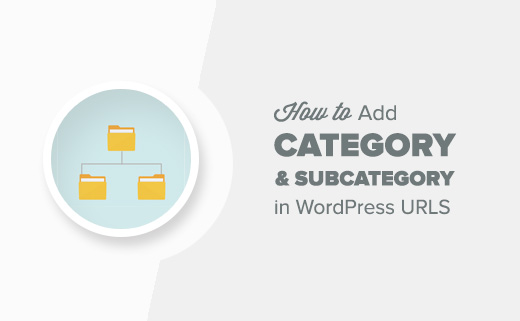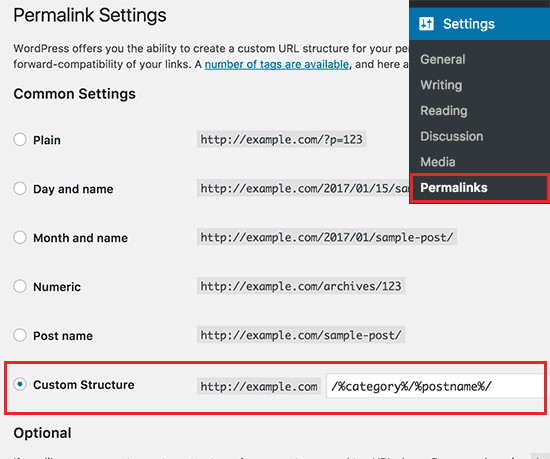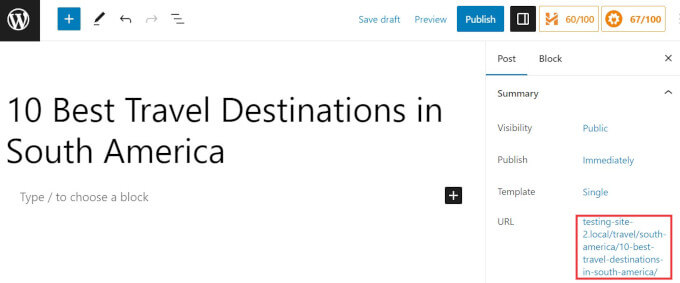Beaucoup de guides de référencement WordPress disent que les permaliens simples sont les meilleurs. Mais après avoir travaillé avec de nombreux sites, nous avons trouvé que ce n’est pas toujours vrai.
Parfois, surtout pour les grands sites, il est préférable d’avoir des URL qui affichent l’endroit où l’on se trouve, comme “yourstore.com/electronics/smartphones/iphone”. Cette structure claire peut faciliter l’utilisation de votre site.
Si vous êtes nouveau sur WordPress, vous vous demandez peut-être comment configurer ce type de structure permalienne pour votre site. Dans ce guide, nous allons vous afficher comment ajouter des catégories et des sous-catégories à vos URLs. Nous verrons pourquoi vous souhaitez le faire, comment le faire en toute sécurité et ce à quoi il faut faire attention.

Quand inclure la catégorie et la sous-catégorie dans les URL de WordPress ?
Certains sites WordPress utilisent des catégories et des sous-catégories dans leur URL lorsqu’ils ont beaucoup de contenu sur leur site et qu’ils veulent mieux les organiser. Chez WPBeginner, nous utilisons cette stratégie pour rendre notre site plus facile à naviguer pour nos lecteurs.
Par exemple :
1 | https://www.wpbeginner.com/plugins/7-best-wordpress-backup-plugins-compared-pros-and-cons/ |
Pour les magasins en ligne, l’inclusion de catégories et de sous-catégories dans les URL fournit un repère visuel sur le contenu auquel les clients/clientes sont sur le point d’accéder, ce qui peut améliorer l’expérience des utilisateurs/utilisatrices.
Par exemple, une URL telle que onlinestore.com/books/fiction/thriller indique que l’utilisateur navigue vers une sous-catégorie spécifique au sein d’une catégorie plus large du site WordPress.
L’inclusion de catégories et de sous-catégories dans les URL peut également aider les moteurs de recherche à comprendre la structure de votre site. L’URL correspondrait à la navigation fil d’ariane de votre site et inclurait davantage de mots-clé et de texte, ce qui rendrait votre site plus propice au référencement.
En savoir plus sur les catégories, vous pouvez lire nos guides sur les taxonomies WordPress et catégories vs identifiants : les meilleures pratiques SEO pour trier votre contenu.
Si vous utilisez la structure d’URL par défaut de WordPress, alors vos catégories et sous-catégories ne sont pas incluses dans les URL des publications. Voyons donc comment ajouter facilement des catégories et des sous-catégories dans les URL de WordPress.
Comment ajouter facilement une catégorie et une sous-catégorie dans les URLs des publications WordPress
Note : Nous ne recommandons pas de modifier les permaliens lorsque votre site WordPress est en direct depuis un certain temps (c’est-à-dire plus de six mois). Dans le cas contraire, vous risquez de perdre votre classement dans les moteurs de recherche.
Si vous devez modifier la structure de vos permaliens, nous vous conseillons de sauvegarder votre site en cas d’erreur et de créer des redirections des anciennes URL vers les nouvelles.
Tout d’abord, vous devez visiter la page Réglages ” Permaliens dans votre tableau de bord WordPress. Là, vous devez cliquer sur l’option ” Structure personnalisée ” dans la zone des Réglages communs.

Ensuite, vous devez ajouter /%category%/%postname%/ dans le champ situé à côté de Structure personnalisée.
Ensuite, n’oubliez pas de cliquer sur le bouton “Enregistrer les modifications” pour stocker vos réglages de structure de permaliens personnalisés.
C’est tout !

WordPress va maintenant commencer à ajouter des catégories et des catégories enfants dans les URLs de WordPress. Vous pouvez voir les réglages des permaliens personnalisés en action en créant une nouvelle publication ou en modifiant une publication existante.
Il suffit d’assigner à cette publication une catégorie (et une sous-catégorie si vous en utilisez) dans la colonne latérale et de cliquer sur le bouton “Mettre à jour”.

Vous remarquerez que le nom de la catégorie et le nom de la sous-catégorie sont inclus dans le permalien de la publication.
À quoi ressemblera l’URL si j’utilise plusieurs catégories ou sous-catégories ?
Imaginons que vous classiez les publications de votre blog WordPress en plusieurs catégories ou sous-catégories.
WordPress inclura uniquement une catégorie et une catégorie enfant dans l’URL. Si vous n’avez pas choisi de sous-catégorie, il affichera uniquement une catégorie mère.
WordPress choisit la catégorie par ordre alphabétique. Par exemple, si vous déposez une publication en utilisant les catégories “Apple” et “Technologie”, WordPress inclura “apple” dans l’URL afin de la classer en premier dans l’ordre alphabétique :
1 | http://example.com/apple/article-title-here/ |
Si vous publiez un article dans la catégorie “Apple” et dans une sous-catégorie appelée “Technologie”, les deux seront incluses dans l’URL :
1 | https://example.com/apple/technology/article-title-here/ |
Si vous avez sélectionné une sous-catégorie mais que vous n’avez pas spécifiquement sélectionné une catégorie parente, WordPress inclura quand même la catégorie parente dans l’URL.
Un autre scénario est celui où vous avez une catégorie parente, une sous-catégorie et une sous-sous-catégorie. WordPress les inclura toutes les trois dans le permalien de WordPress :
1 | https://example.com/apple/technology/events/article-title-here/ |
En savoir plus sur les permaliens, vous pouvez consulter les guides WordPress suivants :
- Comment Retirer les Numéros des URLs WordPress
- Comment Retirer la Date des URLs de WordPress
- Comment modifier les permaliens d’un type de publication personnalisé sur WordPress ?
Nous espérons que cet article vous a aidé à apprendre comment inclure une catégorie et une sous-catégorie dans les URL de WordPress. Vous pouvez également consulter notre article sur la modification du préfixe de base de la catégorie dans WordPress et notre guide du débutant pour créer des taxonomies personnalisées dans WordPress.
Si vous avez aimé cet article, veuillez alors vous abonner à notre chaîne YouTube pour obtenir des tutoriels vidéo sur WordPress. Vous pouvez également nous trouver sur Twitter et Facebook.





AB Juma
Hi there,
Thank you for this. Very helpful.
Just a question – I already have more than 2,000 posts on my website with the day and name url structure. If I change to custom, will those urls change too, or does the change only apply to new posts? Thanks.
WPBeginner Support
Yes, if you change your permalinks it would affect everything on your site. You would want to set up 301 redirects to prevent issues if you change the structure, our guide below should help with that!
https://www.wpbeginner.com/beginners-guide/beginners-guide-to-creating-redirects-in-wordpress/
Admin
Jay
it’s only putting the Parent cateogry in the slug.
How can i make it automatically put subcategory in the url as well?
WPBeginner Support
Please check that the post is only in the subcategory for the most likely reason for that issue.
Admin
Brendon
This seems to break any products that do not use a sub category at all.
WPBeginner Support
It should not cause you trouble with products that don’t have a sub category but if you mean you changed your permalinks then you would want to set up 301 redirects following our guide below:
https://www.wpbeginner.com/wp-tutorials/how-to-create-custom-permalinks-in-wordpress/#redirect-permalink
Admin
Taoheed
I would be glad if you answer this. Let’s assume i published a post into two/three categories or sub-categories, wouldn’t it be treated as duplicate content on google?
WPBeginner Support
It should not cause Google to see it as duplicate content but if you have posts that are in multiple categories then your users would see that same post when they viewed your other categories. We would normally recommend only one category for a post.
Admin
David
Please is there a way to include tags in the URL instead of categories?
WPBeginner Support
We do not have a recommended method for including tags in your URL at the moment, we would recommend taking a look at our article below that covers the organizational differences between the two for why categories are preferred over tags in permalinks:
wpbeginner.com/beginners-guide/categories-vs-tags-seo-best-practices-which-one-is-better/
Admin
Phu Nguyen
Hi,
Currently I have a url: abc.com/games/ff9/weapon-list/
and I can’t create another post with the same name (weapon-list) on another category.
It will be like abc.com/games/ffx/weapon-list-1/
Is there any solution for my case? Looking forward to your help
WPBeginner Support
The end of the URL would be determined by your post’s name and the other sections would be determined by your permalink structure. You cannot have the same name for the time being and would need a different name
Admin
Lori S.
So for pages, it would just skip over the /%category%/ and maintain the original post name?
WPBeginner Support
Yes
Admin
Ashish
Is it a disadvantage to using categories in URL? like example.com/plugin/best-plugin/. in this case plugin uses 2 times. is this URL looks spammy?
WPBeginner Support
You would want to try avoiding looking spammy with your choice of title but it is not a disadvantage to use categories n your URL.
Admin
jacques
Important note: To get URL structure like: /category/child1/child2/POSTNAME then ONLY select “child2” as the post category when editing the post. WordPress will automatically add all parent categories to the URL. Took me a while to figure that out.
WPBeginner Support
Thanks for sharing this for people looking for that permalink setup
Admin
Austin Epple
You’re the man. I’ve been tearing my hair out trying to get these stupid subcategories in the url. Thank you!
Smart
Thank you so much @jacques, you just helped me solve a challenge that has taking me so many hours without solution. Thanks mahn
Rubb
How this work with pages? pages don’t use categories
WPBeginner Support
As they do not have categories, they would not have the category in the URL
Admin
Ben
So how do i redirect from /%postname%/ to /%category%/%postname without the redirection plugin.
WPBeginner Support
For different methods to create redirects we would recommend taking a look at our guide below:
https://www.wpbeginner.com/beginners-guide/beginners-guide-to-creating-redirects-in-wordpress/
Admin
May
Is there a way to add hierarchy to parent categories? If a post has two categories how can I chose which category is used in the URL.
As you say in your article, default is alphabetical.
For example I have a post categorised “Fruit” and “Vegetable” with the permalink set to show /%category%/%postname%/.
The URL shows website.com/Fruit/postname but I want it to use website.com/vegetable/postname.
WPBeginner Support
In those situations, you may want to look into how your categories are organized to see if tags may be what you need more than categories for some organizations. Normally posts shouldn’t be in multiple categories.
Admin
Nik
How can I add category in my page url.
WPBeginner Support
By default, pages don’t have categories so they wouldn’t be included in the page options.
Admin
Mlimasolucoes
Use subcategory as primary category then URL will work
WPBeginner Support
Thank you for sharing that recommendation
Admin
Muhammad Kashif Rasheed
You answer is valuable for me, because I read all the post but not permalink not work fine on my side, when I applied your suggestion I got answer of my question.
Once again thankyou very much,
Sravankumar
I am unable to see subcategory in any posts.
I am facing issue while creating a post name. How can Icreate a URL like this: site/destinations/europe/norway/post-name
I have the page to create a URL like above is it only possible if I create a page or with post name also can we create?
site/destinations/europe/norway/
WPBeginner Support
If I’m understanding the question correctly, you don’t need to create a page at the second link’s location as that would be your subcategory’s page listing the posts in that subcategory.
Admin
Nancy
Can i Include Category and Subcategory in post URLs without using permalink
WPBeginner Support
If you don’t want to edit your permalinks then you would normally need to manually add those using a method in: https://www.wpbeginner.com/wp-tutorials/how-to-create-custom-permalinks-in-wordpress/
Admin
V
Adding /%category%/%postname%/ to the permalink structure breaks the pagination for some reason. Anyone else facing this?
WPBeginner Support
There are multiple possible reasons pagination could not be working, you may want to check with your specific theme’s support or reach out to us using our contact form for which would likely fix the issue.
Admin
jesica
How did you do to link your subcategory menu pages to a clean url: YOURSITE.COM/SUBCATEGORY? without the YOURSITE.COM/CATEGORY/SUBCATEGORY?
I don’t know how to delete the parent category from the subcategory URL on my site…
WPBeginner Support
We don’t have a simple recommended method at the moment. If you want to remove reference to the parent category, should that category be a child category?
Admin
Shubham Dixit
I have an issue. I am using Custom Structure to display category name before the post name ( /%category%/%postname%/ ). It is working fine when I am logged in but after log out It doesn’t display category name in url.
The above issue in in chorme browser. In firefox it is working fine.
Please help!
Ted
Yeah.. we all know this information.. you see %category% and it is obvious what it does. But Thanks….
WHAT I WAS LOOKING FOR is code as in rewrite rules for my themes functions file..
jcdarocha
Hi !
Trick works well for a blog post / category.
but what about woocommerce ? ay idea ?
Even when you add this in permalink structure, WC show the main-category/product-name even if there 2 or 3 sub categories
This is really annoying,
Any idea?
Thank you
Jean-Charles
Paul
Got the same question. Why is that not possible for Woocommerce?!
Any help is appreciated!
Simon
This is great, but how would I go about having multiple URLs for the same post with multiple categories? So if I go from 1 category the URL is for that category and if I go from another it is that category?
Thanks
Jordan
Won’t this cause duplication problems? How do you make it so the parent category doesn’t open to an archive page?
Like as an example – Main topic Music and then have a subcategory called popmusic…..
Music ( Not Clickable )
Pop Music ( Clickable and rediects to your posts associated with that sub categories)
My issue with this is people clicking the parent categories and getting redirected to a page with no post associated with it because you don’t want to have duplicate content or a post in music & pop music
Yash chandra verma
So what will be url if two different parent category are used. Please tell me?
Vale
Why Woocommerce do not support Subcaregories in permalinks?
Google and other browsers recommed clean URL’s. And woocommerce Category slug can not be removed unless you pay $119 Usd for a plugin that does the trick.
Is there another way to achieve these two issues?
Jose
Thanks for this post. Its working for me. The only thing doesn`t work is when i try to list news by a subcategory
Eg. mydomain.com/categorybase/subcategory/nameofnew/
this works showing me the blog post, but if i want to list all posts of this subcategory like this
mydomain.com/categorybase/subcategory/
does’nt work.
Any ideas how to fix it?
Thanks in advance.
Denish Callos
HI,
I have added categories and tags in my pages. Now how do i add categories in pages permalink?
Please suggestion will be highly appreciated.
Thanks
Kahil
This solution ONLY works if you select the subcategory in the post/page category list. If you have both the parent and the subcategories checked, then the parent category is the only one that shows. For those of us using Woocommerce, this messes with the related products. If you select just the subcategory, then you won’t see any related items from the parent category. If you select them both, then you’re back to dealing with not having the subcategory listed in your URL. Been looking for a simple solution to cover both needs.
Paul
Have you found a solution? We have the same exact problem right now. This is quite annoying and we don’t know what to do about it.
Any ideas or solutions are appreciated!
regel
Hi don’t have “permalink” on my setting. Any option?
WPBeginner Support
Hi Regel,
Your website is probably on WordPress.com. Please see our guide on the difference between self hosted WordPress.org vs free WordPress.com blog.
Admin
Giulia Sampogna
Hello,
that´s a really nice post. I am wondering if I change it now will change my past one as well? If yes I would had to redirect all links right?
Thanks a lot
Dan
I’m confused and could use some help.
Specifically, I am developing an ecommerce site that is composed of mostly PAGES. (NOT using woocommerce or another e-commerce platform, but building out my own gravity form for each product page).
I want the product category to be in ALL my PAGE URL’s, but as you know, wordpress out of the box doesn’t enable assignment of categories and tags to PAGES (wish it did). One alternative would be to use one of the plugins I found that could enable this. The other is to simply use the product category name in the SLUG (part of the permalink I can create on the product page). I could also create a page for each product category and include a gallery showing each product item that belongs to that category with a link to its specific page, or, I could skip the product category page altogether and assign the “#” in front of the category name when I create the menu, so that the category name would appear but not be an active link to any category page. I could get involved in creating a “custom post type” for my product pages which would enable them to be assigned a category and tag, much like the woocommerce product “pages” are setup (don’t know much about how to do that but would like to), etc.
Also, the permalink settings effect URL’s for both pages and posts…correct ?
REALLY appreciate a followup post from you that deep dives into helping people like me who are using wordpress for their ecommerce site but not using one of the out of the box ecommerce platforms.
thankyou